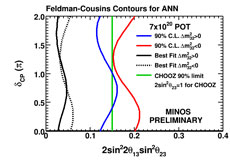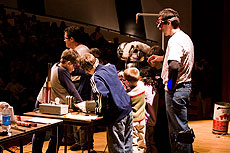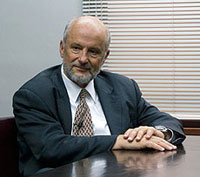|
Have a safe day!
Tuesday, April 13
10:30 a.m.
Research Techniques Seminar - Curia II
Speaker: Satish Dhawan, Yale University
Title: How to Deliver Oodles of Current to HEP Detectors
in High Radiation and Magnetic Fields?
3:30 p.m.
DIRECTOR'S COFFEE BREAK - 2nd Flr X-Over
4 p.m.
Accelerator Physics and Technology Seminar - One West
Speaker: Guoxing Xia, Max-Planck Institute, Munich
Title: Ion Effects in the Electron Damping Ring of the ILC
Wednesday, April 14
3:30 p.m.
DIRECTOR'S COFFEE BREAK - 2nd Flr X-Over
4 p.m.
Fermilab Colloquium - One West
Speaker: Helmut Dosch, DESY
Title: DESY 2020: The New Strategy
Click here for NALCAL,
a weekly calendar with links to additional information.
Upcoming conferences |
|
For information about H1N1, visit Fermilab's flu information site.
|
|
Tuesday, April 13
- Bagel sandwich
- Creamy turkey vegetable soup
- Chili dog
- Country-fried steak
- Chicken cacciatore
- Italian panini w/provolone
- Assorted sliced pizza
- Super burrito
Wilson Hall Cafe Menu
|
|
Wednesday, April 14
Lunch
VEGETARIAN MEAL
- Lasagna rolls w/red pepper sauce
- Sugar snap peas
- Cinnamon apple cake
Thursday, April 15
Dinner
- Spinach & strawberry salad
- Flank steak w/balsamic glaze
- Walnut crusted potato & bleu cheese cakes
- Steamed broccoli
- Chocolate mousse pie
Chez Leon Menu
Call x3524 to make your reservation. |
|
|
MINOS continues the race
 |
| Values of the neutrino-mixing angles and the charge-parity violating phase that produce a number of candidate events in the MINOS far detector are consistent with the observation. Black solid lines show those values that best represent MINOS data if nature prefers the normal hierarchy neutrino mass and dotted lines show the values if nature prefers the inverted hierarchy. Values to the left of the blue lines are allowed at the 90 percent confidence level interval for the normal hierarchy, and red lines for the inverted hierarchy. The green line shows the CHOOZ upper limit. |
MINOS is used to neutrinos going missing. This time, the collaboration had hoped to find a few extra. The MINOS experiment collaboration presented a new result at Fermilab last week from an analysis that looked for one type of neutrino in a beam made up of another type. This new result constrains one of the unknown neutrino parameters, known as theta 13, or θ13.
Scientists know that there are three types, or flavors, of neutrinos (muon, electron and tau). In the last decade, they've discovered that these particles have mass, and they can switch between the different flavors. MINOS studies a beam of muon neutrinos created at the NuMI facility at Fermilab. Collaborators first measure those neutrinos at the experiment's near detector, located at Fermilab. From those measurements, collaborators predict how many of those muon neutrinos they should see in the far detector, located in northern Minnesota. It turns out that some of the muon neutrinos that scientists expect to see at the far detector don't show up. Those muon neutrinos are changing into a different flavor, or oscillating, on their way up north.
MINOS scientists expect the muon neutrinos that they produce to change predominantly into tau neutrinos on their journey, but a small fraction could change into electron neutrinos. Observing such a transformation would require a non-zero value of θ13, one of the few remaining unknown pieces of the physics governing neutrino oscillations. Several experiments are in the process of measuring or will soon measure θ13. Scientists are eager to observe such a transformation, as it could help answer existential questions regarding the abundance of matter over antimatter in our universe.
Read more |
Tevatron sets new initial luminosity record
The Tevatron set a new initial luminosity record Monday. Store number 7737 reached 377.4 µb-1/s, breaking the previous record set less than a month ago. The previous record, 376 µb-1/s, was set on March 18. The unit of measurement µb -1/s is roughly equivalent to 70,000 proton-antiproton collisions per second.
|
Wonders of Science show this Sunday, April 18
 |
| Children enjoy the annual Wonders of Science show in 2008. This year's show takes place from 1-2 p.m. on Sunday. |
High school teachers will take science out of the textbook and put it into children's hands at Fermilab's annual Wonders of Science event.
"The show is an excellent opportunity for families to share a fun time together while learning about science," said Nancy Lanning of the Fermilab Education Office.
On Sunday, April 18, from 1-2 p.m. award-winning high school teachers will perform fast-paced demonstrations on chemical and physical phenomena. Portions of the 22-year-old event have appeared on TV shows such as "Late Show with David Letterman", "Inside Edition" and "CBS News."
"This is one of our most exciting events every year," said Spencer Pasero, an education program leader at Fermilab. "Everyone has their favorite demonstration, but there is always something new and exciting to look forward to."
This year's performance, which will have an electricity and magnetism theme, will involve "Weird Science," a group of current and retired high school teachers who were recognized locally and nationally for their ability to engage young minds. That group includes Lee Marek of the University of Illinois at Chicago (formerly of Naperville North High school.), Karl Craddock, of Fremd High School in Palatine and Bill Grosser of Oak Park-River Forest High School.
The program is designed for ages 7-12. Scout troops are welcome. Students will receive a science kit, which they can use to replicate the experiments at home. Tickets are $4 and may be ordered using a printable registration form.
For additional information, contact Nancy Lanning at edreg@fnal.gov.
|
Wonder lust: Soudan mine
From New Scientist, April 11, 2010
SEVEN hundred metres below the mountainous terrain of Soudan, Minnesota, lurks part of one of the most important experiments in particle physics. A unique box of tricks designed to detect neutrinos beamed from Fermilab, about 725 kilometres away in Batavia, Illinois, is buried here. This sensitive experiment is sited deep down in this old iron mine to shield it from the "noise" of cosmic rays raining down on the Earth.
I visited the mine to see the experiment for myself. Delving this far down into the Earth's crust is a haunting experience. And the MINOS neutrino detector - 6000 tonnes of steel and plastic - is a sight to behold, towering above like something from the lair of a James Bond villain.
Read more
|
|
|
Creating the right environment
 |
| Fermilab Director Pier Oddone |
A colleague of mine at Berkeley use to say that to attract the best scientists and engineers to the lab required us to "to make the air right." The air was right if people coming to the laboratory found an atmosphere that supported their free inquiry, encouraged them to pursue scientific research wherever it took them, and allowed them to get things done with a minimum of fuss. Attracting the "best and brightest" to the national laboratories was one of the two topics that Bill Brinkman, Director of the DOE Office of Science, chose for discussion at the OS Lab Directors Meeting last week.
One remarkable observation at the end of the discussion was that attracting the "best and brightest" to the national laboratories touched on almost every issue imaginable related to the management of the national laboratories. There was consensus on the attractors and barriers. Among the attractors we agreed on were:
- world class colleagues,
- compelling research,
- scientific environment and facilities
- career development and
- a vibrant surrounding community.
Creating and maintaining each of these attractors requires a number of elements, nearly all of which we are fortunate to have at Fermilab. Similarly there was consensus on the barriers that are common at national laboratories:
- DOE/Lab bureaucracy,
- unstable funding,
- branding relative to universities,
- poor physical infrastructure and
- compensation.
At different levels, these barriers clearly affect us at Fermilab.
One important conclusion of the meeting was that we at the laboratories together with the DOE can take concrete steps to enhance the attractors and to greatly moderate the barriers. In particular, the initiative undertaken by Secretary Chu to decrease directives and orders and streamline bureaucratic requirements coupled with a look at what we at the laboratories impose on ourselves could make a very big difference in "making the air right." For us as a single program laboratory, however, the overriding issue remains a compelling vision and strategy for the future of our field that we and the DOE agree on.
|
Correction
In the figure caption of last Friday's Result of the Month, Kaori Maeshima's title was incorrect. She is the U.S. CMS operations manager. Erik Gottschalk is in charge of the Fermilab Remote Operations Center. We regret the error.
|
|